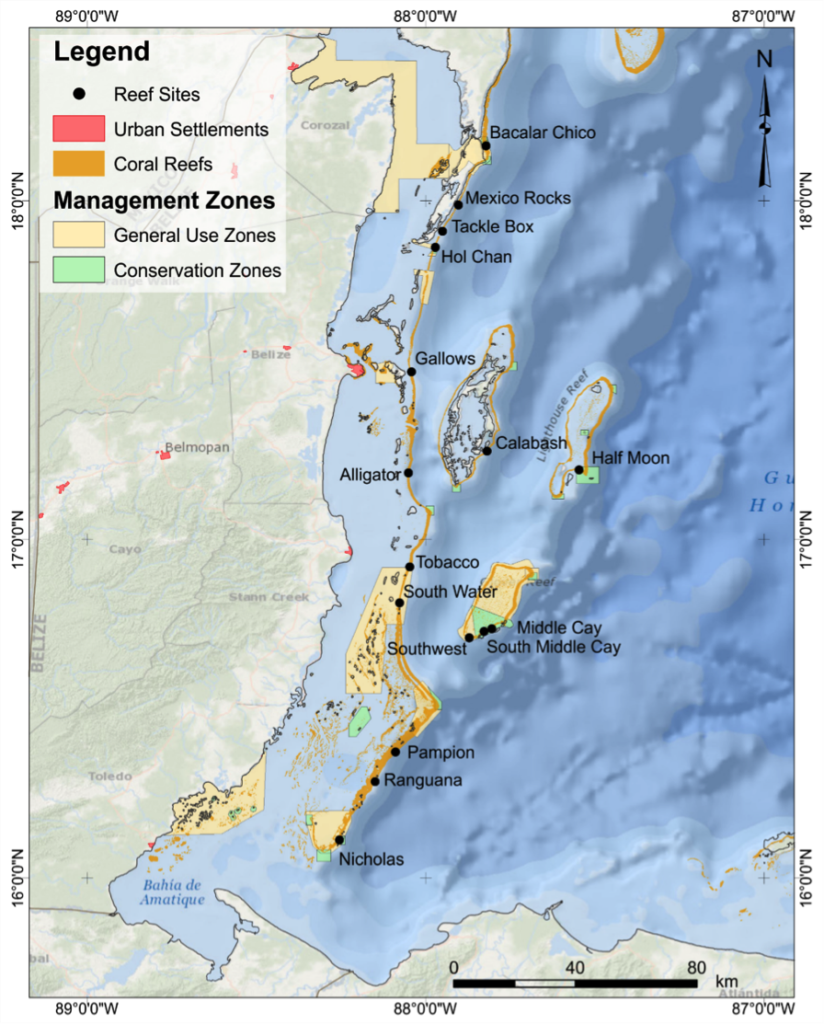I arrived in Belize yesterday with three former lab members (Abel Valdivia from CBD, Courtney Cox from the Smithsonian, and Jenny Hughes, a recent graduate from UNC). Although field ecology is really fun (if pretty challenging) we are actually here to work. In 2008 my lab took over a reef monitoring program Melanie McField set up in the mid 1990s to track the state (AKA “health”) of reefs along the Meso-American reef in Belize (we also work in Mexico and Honduras). Most years, we come down in May after classes are over to survey 16-19 sites from the north, just below the Mexican border, all the way down to the far-offsore cays near Honduras.
The sites are all on fore reefs, between 35 and 45 feet, with our transects typically ending just above the drop-off at 6oish feet. About half the sites are “protected” (to some degree, e.g., from fishing, etc.). The general purpose of the long-term project is to measure and understand changes in the reef ecosystem on what is one of the world largest barrier reefs. The sites were already pretty degraded when Mel started but there has been further loss of coral cover and fish biomass and a large increase in fleshy macroalgae over the last 20 years. The causes are numerous including coral diseases, ocean warming, possibly poor water quality due to coastal development that leads to sediment and sewage pollution, and of course overfishing. Although it’s a really cool place, the reefs are in pretty piss poor shape with few corals and fewer large fishes.
In the past, we’ve also had shorter-term projects to measure the effectiveness of the protected areas in conserving or restoring corals and fishes (not very), the impacts of invasive lionfish on native fish communities (insignificant), and we’ve brought corals back from multiple sites to our coral reef ecosystem lab in Chapel Hill to measure the relative and interactive effects of ocean warming and acidification on coral survival and calcification (the negative effect of warming is far greater).
This year, we are continuing a study of whether the national ban on the catch and sale of any herbivorous fish (including parrotfishes), implemented in 2009, has effectively restored parrotfish populations and herbivory, thereby reducing the cover and biomass of macroalgae. The last time we checked in 2013, we saw inconclusive hints of increases in the biomass and density of stoplight parrotfishes (a key species here). It has now been 7 years since the law went into effect and if it has been reasonably well-enforced (and our forensic marketplace monitoring suggests that it more or less is), we should see measurable, even large increases in parrotfish biomass.
Basically there are three possible outcomes: 1) no increase in parrotfishes. 2) an increase in parrotfishes but no subsequent decline in seaweed. 3) increased parrotfish biomass and decreased seaweed cover. My money is on scenario 2. Scenario 1 could result from continued harvesting or parrotfishes, to increases in predators (sharks, etc., which is unlikely but we will test for this), or because parrotfishes from the larval source are being over harvested and if local populations are not self-seeding (if all the baby parrotfishes from reefs in Belize migrate to Mexico and if all of Belize’s babies come from Honduras, local protection in Belize won’t have much effect on population density. I’ll report back next week on this.

Leave a Reply